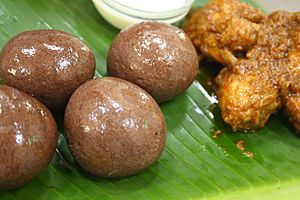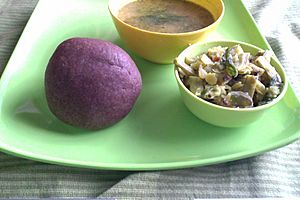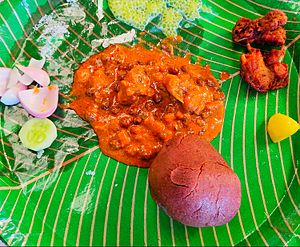Ragi mudde facts for kids
 |
|
| Alternative names | Ragi Sangati, Ragi kali |
|---|---|
| Course | Lunch or Dinner |
| Place of origin | India |
| Region or state | Karnataka, Andhra & Telangana, Tamilnadu |
| Serving temperature | Hot |
| Main ingredients | Finger millet |
| Variations | Akki Tari mudde (coarse rice flour), Jorwar millet mudde |
Ragi mudde, also known as ragi sangati or kali, is a healthy and filling meal. People sometimes just call it mudde (which means 'lump') or hittu ('flour'). It is very popular in the state of Karnataka and the Rayalaseema region of Andhra Pradesh in India. Many people in the countryside of Karnataka enjoy it often. In Tamil Nadu, especially in the western part, it is called ragi kali. Ragi mudde is a main food in areas like Kolar, Mandya, Hassan, Mysore, and Tumkur in Karnataka, and the Rayalaseema Region in Andhra Pradesh. A similar dish called Dhindo is also eaten in Northeast India, Nepal, and Bhutan.
How to Make Ragi Mudde
Ragi mudde is packed with good nutrients and needs only two ingredients: ragi (which is finger millet) flour and water.
First, a small amount of ragi flour is mixed with water to make a thin paste. This paste is then added to a pot of boiling water on the stove. As the mixture boils, more ragi flour is added. This forms a mound on top of the boiling water.
Once the flour is added, it needs to be mixed right away to prevent lumps. This is done with a special wooden stick called a mudde kolu. The flour is beaten until it becomes a smooth, dough-like mixture without any lumps. Then, it cooks on medium-high heat.
After cooking, the hot dough rests on low heat. Finally, it is shaped into tennis-ball-sized balls using wet hands on a wooden board.
How to Eat Ragi Mudde
Mudde itself does not have a strong taste. Traditionally, ragi mudde is eaten with saaru. This is a type of gravy or soup made from greens, sprouted grams (whole pulses), meat, or vegetables. You can also eat it with yogurt or buttermilk.
A popular way to enjoy ragi mudde is with bassaru. This combination is a favorite among farming families in Karnataka. Bassaru is made from the water left over after steaming different kinds of pulses, often with garlic. This water gets a nice earthy flavor from the pulses, which goes well with the earthy taste of the mudde.
To make bassaru, browned onions, red chilies, and some garlic are ground into a paste with grated coconut. This paste is added to the pulse water. The mixture is then seasoned with a special tempering called oggarane. The steamed pulses themselves are often used to make a dry side dish called palya.
Another common side dish for mudde is uppesru or uppsaaru. This is often a simple stew made from steamed horsegram and the water used to steam it, with added salt. Sometimes, hyacinth-beans are used instead of horsegram. The horsegram version is also known as hurLi saaru.
Health Benefits
Ragi mudde is very healthy because it is rich in the same nutrients found in finger millet. These include lots of fiber, calcium, and iron.
What to Eat Ragi Mudde With
Ragi mudde is commonly eaten with famous Karnataka-style upsaaru, bassaaru, or nati koli saaru (which is chicken curry). It can also be enjoyed with menthyada gojju, a sweet and sour dish made from fenugreek and tamarind.
In most of southern Karnataka and the old Mysore region, people eat it almost every day. Even some fancy hotels serve ragi mudde for special events. In the Rayalaseema region of Andhra Pradesh, it is eaten with pappu (lentil stew) and chatnee. Ragi sankati is also a main food in Anantapur district and is served in almost all hotels there.



